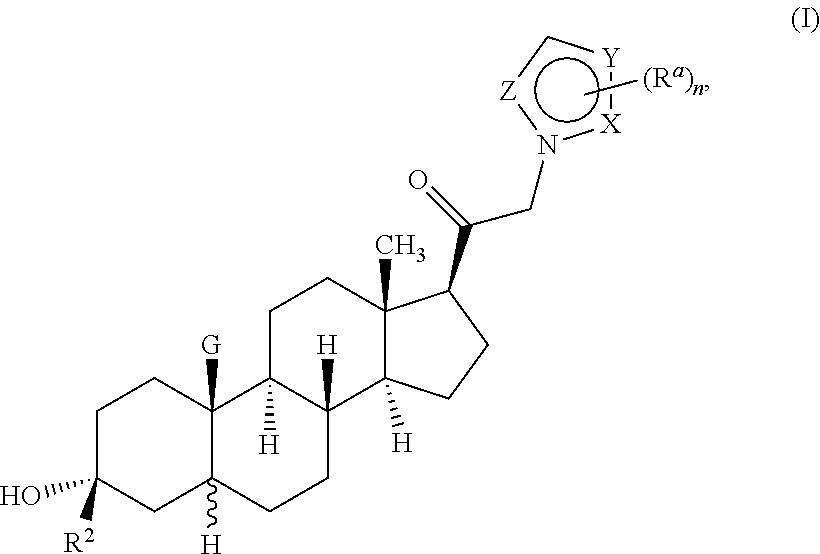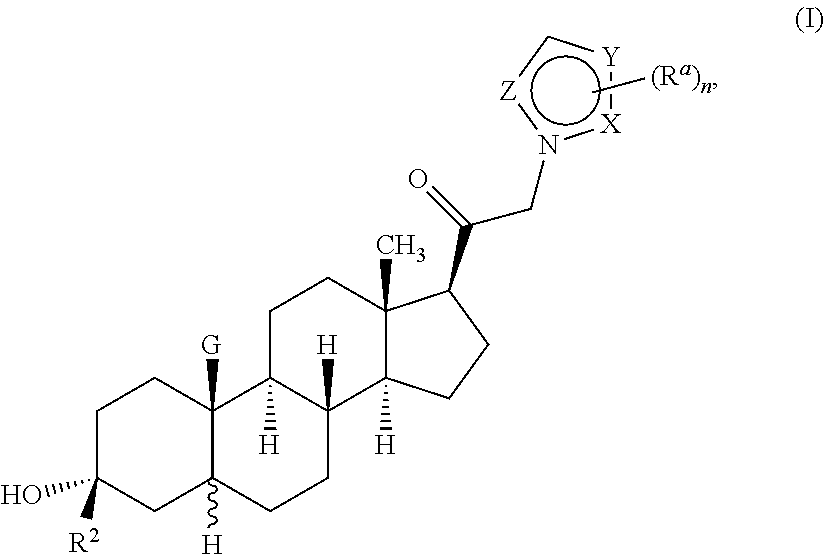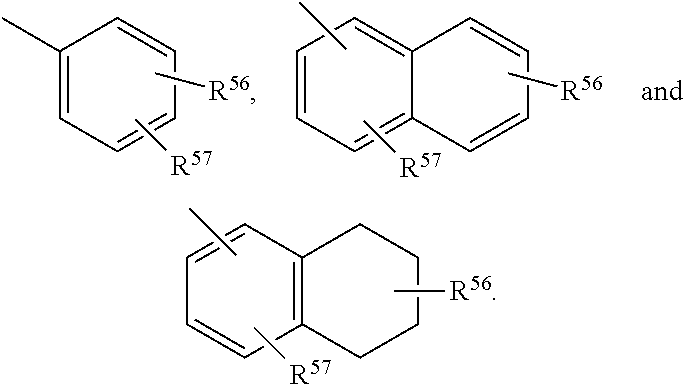Neuroactive steroids, compositions, and uses thereof
a technology of neuroactive steroids and compositions, applied in the field of neuroactive steroids, can solve the problems that progesterone is not consistently effective in the treatment of the aforementioned syndromes, and achieve the effect of optimal chemical reactivity and biological activity
- Summary
- Abstract
- Description
- Claims
- Application Information
AI Technical Summary
Benefits of technology
Problems solved by technology
Method used
Image
Examples
example 1
Synthesis of Compounds 1 and 2
[0337]
[0338]To a solution of C1 (1 g, 2.26 mmol) in acetone (150 mL) was added K2CO3 (937 mg) and 5-chloro-2H-benzo[d][1,2,3]triazole (520 mg, 3.39 mmol). The mixture was stirred at 25° C. for 2 hrs. The solvent was removed by rotary evaporator. To the mixture was added water (80 mL) and EtOAc (120 mL). The organic layer was separated. The aqueous phase was extracted with EtOAc (2×100 mL). The combined organic layers were washed with brine (200 mL), dried over Na2SO4, filtered and evaporated to afford crude product, which was purified by preparative HPLC to give two compounds. The further purification was conducted by SFC to afford compound 2 (157 mg, 13%) and compound 1 (100 mg, 9%).
[0339]1: 1H NMR (400 MHz, CDCl3) δ 7.99 (d, J=9.3 Hz, 1H), 7.37-7.31 (m, 2H), 5.44-5.30 (m, 2H), 3.54 (d, J=9.0 Hz, 1H), 3.33 (s, 3H), 3.22 (d, J=9.3 Hz, 1H), 2.74-2.66 (m, 1H), 2.28-1.71 (m, 8H), 1.70-1.46 (m, 9H), 1.45-1.20 (m, 9H), 0.71 (s, 3H). LCMS Rt=0.943 min in 1.5 ...
example 2
Synthesis of Compounds 7 and 8
[0341]
[0342]The synthesis of compounds 7 and 8 were carried out in a similar manner to the protocol outlined in Example 1.
[0343]7: 1H NMR (400 MHz, CDCl3) δ 7.41-7.34 (m, 1H), 7.08-7.04 (m, 1H), 5.41-5.34 (m, 2H), 3.55 (d, J=9.2 Hz, 1H), 3.48-3.41 (m, 2H), 3.26 (d, J=9.2 Hz, 1H), 2.73-2.68 (m, 1H), 2.25-2.10 (m, 2H), 2.00-1.90 (m, 2H), 1.85-1.35 (m, 17H), 1.30-1.10 (m, 8H), 0.69 (s, 3H). LCMS Rt=2.503 min in 3 min chromatography, MS ESI calcd. for C30H40F2N3O2 [M+H-H2O]+512, found 512.
[0344]8: 1H NMR (400 MHz, CDCl3) δ 7.66-7.63 (m, 1H), 7.32-7.25 (m, 1H), 5.58-5.50 (m, 2H), 3.56 (d, J=9.2 Hz, 1H), 3.48-3.41 (m, 2H), 3.26 (d, J=9.2 Hz, 1H), 2.70-2.61 (m, 1H), 2.25-2.10 (m, 2H), 2.00-1.90 (m, 2H), 1.85-1.35 (m, 17H), 1.30-1.10 (m, 8H), 0.72 (s, 3H). LCMS Rt=2.168 min in 3 min chromatography, MS ESI calcd. for C30H40F2N3O2 [M+H-H2O]+512, found 512.
example 3
Synthesis of Compounds 9 and 10
[0345]
[0346]To a solution of C1 (1 g, 2.26 mmol) in acetone (150 mL) was added K2CO3 (937 mg, 6.78 mmol) and 4,6-difluoro-2H-benzo[d][1,2,3]triazole (525 mg, 3.39 mmol). The mixture was stirred at 25° C. for 2 hrs. The solvent was removed by rotary evaporator. To the mixture was added water (80 mL) and EtOAc (120 mL). The organic layer was separated. The aqueous phase was extracted with EtOAc (2×100 mL). The combined organic layers were washed with brine (200 mL), dried over Na2SO4, filtered and concentrated to afford crude product, which was purified by preparative HPLC to give a mixture of two compounds. The further purification was conducted by SFC to give 9 (168.9 mg, crude) and 10 (25 mg, 2%). Compound 9 was purified by SFC second time to afford compound 9 (91.3 mg, 8%).
[0347]9: 1H NMR (400 MHz, CDCl3) δ 6.86 (dt, J=1.8, 9.5 Hz, 1H), 6.79 (dd, J=1.6, 7.4 Hz, 1H), 5.44-5.30 (m, 2H), 3.52 (d, J=9.0 Hz, 1H), 3.32 (s, 3H), 3.21 (d, J=9.0 Hz, 1H), 2.74...
PUM
| Property | Measurement | Unit |
|---|---|---|
| membrane voltage | aaaaa | aaaaa |
| time | aaaaa | aaaaa |
| time | aaaaa | aaaaa |
Abstract
Description
Claims
Application Information
 Login to View More
Login to View More - R&D
- Intellectual Property
- Life Sciences
- Materials
- Tech Scout
- Unparalleled Data Quality
- Higher Quality Content
- 60% Fewer Hallucinations
Browse by: Latest US Patents, China's latest patents, Technical Efficacy Thesaurus, Application Domain, Technology Topic, Popular Technical Reports.
© 2025 PatSnap. All rights reserved.Legal|Privacy policy|Modern Slavery Act Transparency Statement|Sitemap|About US| Contact US: help@patsnap.com



